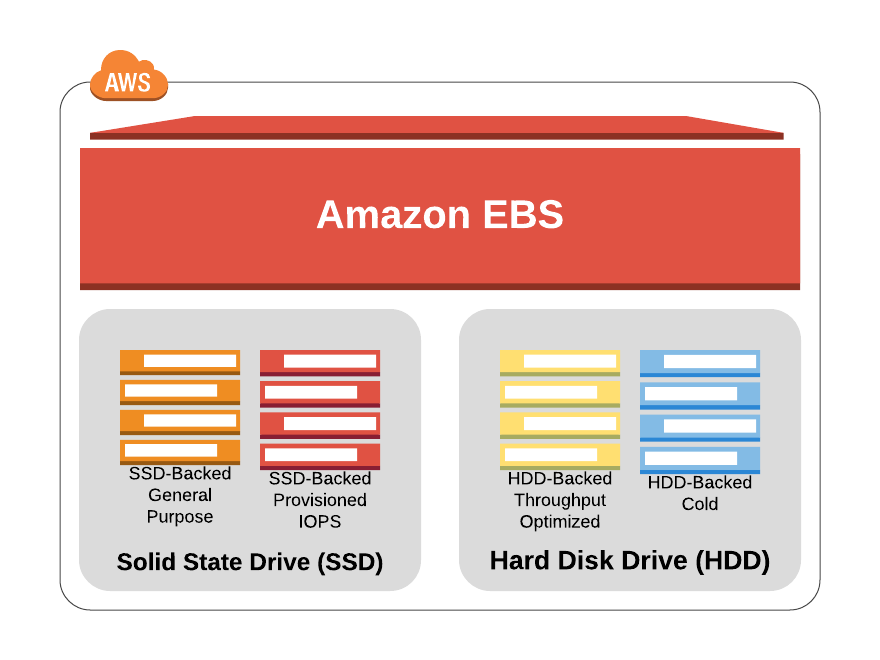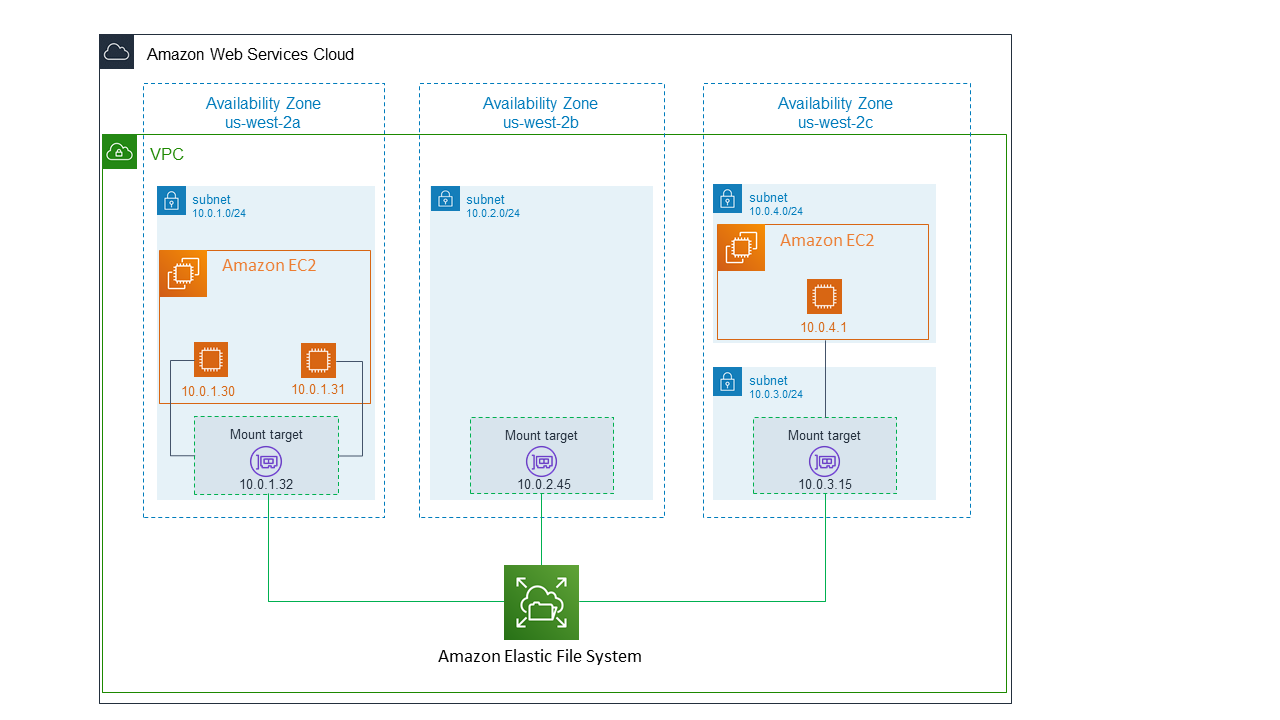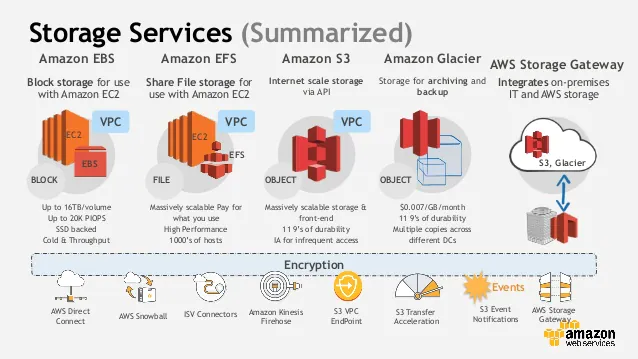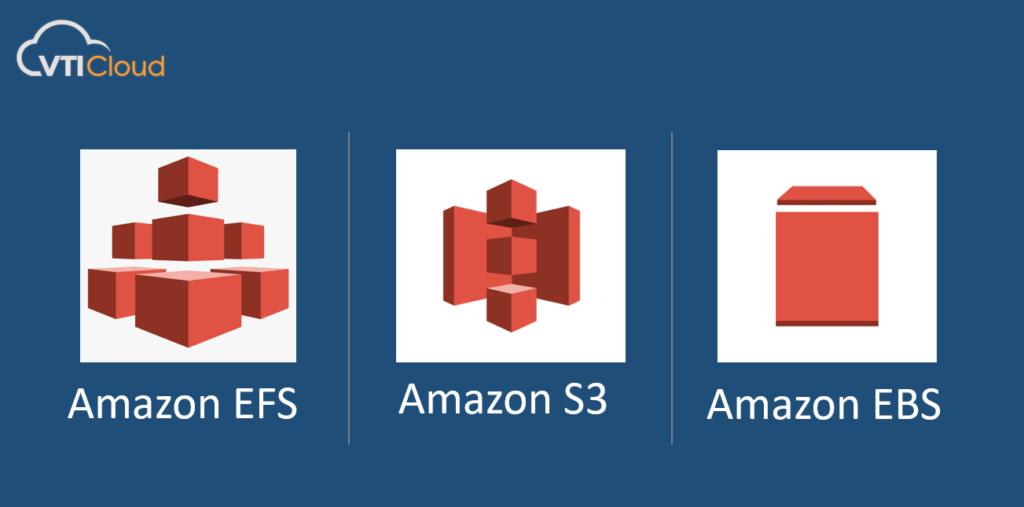Amazon Web Services (AWS) has over 200 full-features services for a variety of technologies, industries, and uses; with such a large number of services AWS often confuses beginners even professionals. This is especially true when it comes to the storage services AWS offers its users. Knowing the benefits and use cases of storage services will help come up with the best solution model. In this article, we’ll look at a trio of AWS storage services: Amazon S3, Amazon EBS, and Amazon EFS.
So, what are these services, and what is used for hosting? Get started with Amazon Simple Storage Service.
Amazon S3 – One of the most popular AWS storage services
Amazon S3 storage is an AWS object storage solution. If you’ve ever used one of those services like Google Drive or Dropbox, you’ll know how S3 works. At first glance, Amazon S3 is simply a place to store files, photos, videos, and other documents. However, after a closer look, you will discover many other interesting functions of this service.
Amazon S3 is the best proof of where to pay as you go and scalability. This service will respond to an increase in project storage and count only the correct number of resources you use.
You also easily manage data, control who accesses your content. At the same time, you can protect your data from all kinds of threats. Amazon S3 replicates data to ensure data durability and lets you choose between different storage layers to save costs.
In fact, Amazon S3 is seen as an extremely powerful data storage tool, even tech giant Netflix is using the service for storage. Besides Netflix, many of the websites you visit daily are also hosting directly on S3 or using content stored in S3 buckets. Consider some of the following scenarios to better understand how S3 is used.
Amazon S3 Use Cases
Scenario 1: Data loss prevention
Have you ever accidentally deleted something important? Amazon S3 has backup and restore capabilities to ensure users do not lose data by protecting deleted data and creating instances. Creating a version means that AWS saves a new version of the file every time the file is updated, and the delete protection feature ensures the user has the appropriate permissions before deleting the file.
Scenario 2: High availability
What will a company do when there is an unexpected power outage or if the on-premises data center suddenly crashes? Data stored in the Amazon S3 service infrastructure is protected in an Amazon-managed data center, similar to the data centers Amazon uses to host well-known shopping websites around the world. By using this service, users get alternative storage options without having to pay rent directly and the utilities of a physical website.
That’s why Amazon S3 has an SLA of 9 (99.9999999999%). In addition, it is possible to copy data to another region to prevent data loss through VTI Cloud’s article: Deploy Multi-Region S3 Replication with just 01 command | VTI CLOUD
Scenario 3: Long-term storage with cost savings and safety
Some businesses need to store financial, medical, or other data for long periods of time as defined by that industry standard, for example, 10 years of health. AWS allows users to store this type of data with S3 Glacier. S3 Glacier is a cost-effective storage solution and one of the best on the market today.

Amazon EBS – The most popular block storage service
Amazon Elastic Block Store (Amazon EBS) is the generic name for all AWS block storage services. Unlike Amazon S3, EBS provides only one volume of storage directly connected to Amazon EC2 (Elastic Cloud Compute). The service allows users to store files directly on an EC2 instance while allowing that instance to access files quickly at a fairly cheap price.
Users can customize EBS capacity with the most suitable configuration for workloads. For example, if you have workloads that require greater throughput, you can choose a Throughput Optimized HDD EBS hard drive. If you don’t have any specific needs for workloads, you can choose EBS General Purpose SSD. If you need a high-performance volume then an EBS Provisioned IOPS SSD will be the best choice for you.
In the most understandable way, Amazon EBS works with Amazon EC2 in the same way that hard drives work on computers. Amazon EBS enables files to be saved directly to an EC2 instance. With this storage capacity, EC2 can do some pretty powerful work that without EBS is almost impossible to do. Let’s take a look at a few examples.

Amazon EBS Use Cases
Scenario 1: Meeting database workloads
Many companies look for cost-effective options for running databases. Amazon EBS provides both Relational Databases (used for Amazon RDS) and NoSQL (used for Amazon DynamoDB) with solutions that are flexible and ensure low latency. Messaging applications – Slack, which is using Amazon EBS to increase database performance to better serve customers around the world.
Scenario 2: Backup and Restore
Một trường hợp sử dụng khác liên quan đến việc sao lưu các instance của bạn. Các bản sao lưu người dùng tạo trong EBS có thể dễ dàng được tải lên S3 để lưu trữ thuận tiện và tiết kiệm chi phí. Bằng cách này, người dùng có thể khôi phục dữ liệu tại một thời điểm nhất định nếu cần.
Amazon EFS
With Amazon Elastic File System (EFS), businesses can share file data from multiple EC2 instances or on-premises instances. Amazon EFS is a flexible serverless service. EFS automatically increases and shrinks depending on the user’s need to store files without provisioning or managing.
Some of the outstanding advantages of EFS: the ability to divide data between storage classes that are accessed frequently or insularly, helping users optimize costs of use. Amazon EFS is considered the most basic AWS solution, capable of supporting other services such as Amazon Elastic Container Service (ECS) and AWS Lambda.
Imagine an international company with hundreds of EC2 instances with each instance hosting a web application. Hundreds of thousands of people are accessing these servers on a regular basis – thus creating huge amounts of data. Amazon EFS is an AWS tool that allows users to connect data collected from hundreds, even thousands of instances so that users can perform data analysis and gather business insights.
Amazon EFS Use Cases
Scenario 1: Machine Learning and Big Data
Amazon Elastic File System (EFS) provides an easy-to-use, high-performance, and consistent file system for machine learning and big data workloads. Millions of data scientists use EFS to create processing environments for their large workloads.
Scenario 2: Information management and web applications
EFS provides an effective means of managing content and web applications. EFS implements a variety of file structures that web development teams typically use, making it easy to learn and deploy in web applications such as websites or other online content.
Companies like Discover and Ancestry when moving from old storage systems to Amazon EFS, have saved large amounts of money due to reduced management costs and time.

Comparing 03 AWS Storage Services

Let’s review the differences between the 03 popular AWS storage services in the table below:
|
|
Amazon S3 |
Amazon EBS |
Amazon EFS |
|
Storage type |
Object storage (objects such as photos, videos, documents, …) |
Block storage for an EC2 instance |
File storage system for EC2 instances |
|
feature |
Access to any service or person |
High performance for the workloads of a single EC2 instance |
High consistency, simultaneous access, and file lock features |
|
Use case |
Web apps, content management, photos, videos, backups, and big data |
Push volume, transactions, NoSQL databases, data warehouses & ETL |
Main directory, database backup, developer tools, container storage, big data analysis |
|
Maximum storage |
Unlimited |
2 options: 16 TB or 64 TB |
Unlimited |
|
Maximum file size |
One object: 5 TB |
Maximum file size = maximum volume size |
Single file: 47.9 TB |
|
Latency |
Low latency for different types of requests; Can integrate with CloudFront for lower latency |
Lower latency efs and S3 SSD is the lowest type of latency |
Low latency, use maximum I/O mode for higher performance |
|
Throughs |
Multiple GBs per second; Multi-part loading support |
Up to 2 GB per second, HDD is high through mass |
10+ GB per second; Bursting through through mode will vary according to the size of the file system |
|
Durability |
Multiple AZs, 99.9999999999% durability (11 9’s) |
Hosted in one AZ only |
Hosted on Multi AZs |
|
Availability (SLA) |
S3 Standard – 99.99% S3 Standard-IA – 99.9% S3 One Zone-IA – 99.5% S3 Intelligent Tiering – 99.9% |
Volume – 99.999% |
File System – 99.9% (Multi-AZ) |
|
Scalability |
Unlimited scalability |
The ability to expand vertically by reconfiguring the volume category; The ability to expand horizontally by mounting and separating additional volumes to and from EC2 |
EFS file system grows and shrinks when users upload/delete files |
|
Access data |
Can be accessed over the internet by millions of people; Has a REST web interface |
Often accessed by an EC2 instance in a single AZ; The exception is Amazon EBS (a single IOPS provisioned volume that can be attached to 16 Nitro Instances) |
Can be accessed by thousands of EC2 instances from different ANEs, regions, or accounts |
|
Service endpoint |
In VPC; No VPC (S3 URL) |
Within a VPC |
Within a VPC |
Summary
Amazon S3 is an object storage service, such as photos, videos, files, and basic websites.
Amazon EBS is a block storage service for EC2 instances, as simple as a computer’s hard drive.
Amazon EFS is a file storage system for many EC2 instances.
Through these explanations, VTI Cloud hopes that you have grasped the most fundamental differences between three most popular AWS storage services, thereby supporting the building of a more accurate and optimal AWS system architecture.
About VTI Cloud
VTI Cloud is an AWS Advanced Consulting Partner with a team of over 50+ AWS certified solution engineers. With the desire to support customers in their digital transformation and transportation journey to the AWS cloud, VTI Cloud is proud to be a pioneer in solution consulting, software development, and AWS infrastructure deployment for customers in Vietnam and Japan.
Building safe, high-performance, flexible, and cost-optimized architectures for customers is VTI Cloud’s top mission in the mission of enterprise technology.












